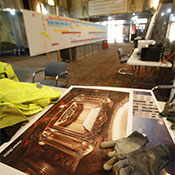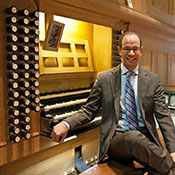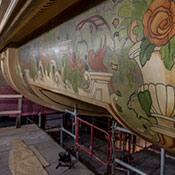
Symphony Center Update: Fall 2019
DAVID LEWELLEN
PUBLISHED
Tagged Under: 2019.20 Season, Grand Theater, In the News
John Roloff has given this tour a few times before.
“The number one question I get is parking,” says the Milwaukee Symphony’s point person on the construction of the new concert hall, standing amid scaffolding that fills the entire volume of the Warner Grand auditorium. “The number two question is bathrooms. The number three question is aisles.”
The quick answers are: The Avenue’s garage across the street has ample parking, and the front door of that repurposed mall is close to the front door of the new hall. The orchestra will also offer convenient valet services for patrons. The new additions to the space will feature many new bathrooms, with more women’s toilets than men’s. The main floor of the auditorium will have two aisles that divide the seating in thirds – no more pushing past 25 people to get to the center.
“And the number four question,” Roloff continues, “is what’s the biggest surprise so far. And the answer is what great shape the building is in. A lot of surfaces just need to be cleaned, not restored.”
For much of that, the symphony and future concertgoers can thank the Marcus Corporation, which owned the theater until 2017, when it was sold to the MSO. “There were a lot of places where they could have saved money and damaged the historic fixtures, but they didn’t,” Roloff said. And for the 20-plus years that the theater stood empty, the company heated and maintained the building.
The historic movie palace on West Wisconsin Avenue, which will become the MSO’s full-time home in September 2020, is starting to look more like a historic movie palace and less like a forgotten pharaoh’s tomb. While scrupulously restoring the 1931 Warner Grand Theater, the symphony is also wrapping the original building in two additions full of modern amenities – catering kitchens, party rooms, HVAC equipment, loading docks, and yes, new bathrooms.
On the balcony level, the original men’s and women’s bathrooms will be restored, including the green, black and lavender tile. It’s not really a choice, because keeping the building’s original appearance is necessary to earn historic preservation tax credits, which are an important part of supporting the $90 million project. (As a nonprofit, the symphony does not pay taxes, but it can sell the tax credits to other developers.)
Following the move of the historic rear wall last summer, the resulting 35-foot gap has been filled in with cinder block, and the wall has been reinforced from inside. “In effect, it’s a 625-ton piece of art hanging over Second Street,” said Roloff, the symphony’s senior director of orchestra and facility operations.
The north addition, which mostly houses the unglamorous mechanical equipment for running a modern building (including spring-mounted brackets to keep heating ducts from rattling), is now fully enclosed. Concrete and steel are in place for the south addition, which will be an event space fronting on Wisconsin Avenue adjacent to the auditorium.
Many touches in that new atrium will remind visitors of classical music; metal accents will be made of brass, black and white marble will look a little like piano keys, and the wood veneer will be reminiscent of string instruments. A skylight in that space will also offer a view of the mural on the office tower above the concert hall, painted in the 1980s by Richard Haas. (Above the hall, four floors of the office tower will be used for the MSO’ music library, office space, and a classroom or warmup space.)
The soaring lobby, along with the concert hall, is currently “scaffolded up like the Sistine Chapel,” Roloff said, so that artisans from Conrad Schmitt, the New Berlin studio that specializes in building restoration, can get up close with the original paint, plaster, metal, and other decorative surfaces.
How the sound will bounce off those surfaces, of course, is a vital question, and Roloff said that representatives of the MSO’s acoustical firm are on site at least once a month to check progress. On the ground floor, the space at the very rear, far underneath the balcony, has been converted into a bar and a control booth, because “it’s a bass trap. It would have been the worst sound in the house.”
Roloff, whose original job description was supervising the symphony’s daily orchestra operations, finds that in his new role, “I’m using words that I didn’t know two years ago. I got sucked into it because when I was a kid, I played with Legos too much.”



